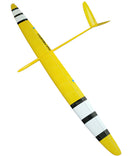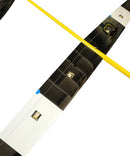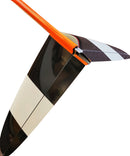Description
Pike Precision 2, F3B, LDS Installed, Yellow/Carbon/White
Includes protective covers and ballast/spacers
LDS Installed-
Ailerons- MKS 6130 (servos not included)
Flaps- MKS 6130 (servos not included)
Pike Precision 2 - a new design by Benjamin Rodax and Philip Kolb
Evolutionary design
In contrast to many new F3B and F3F model developments that are focusing more on single tasks such as launch height or speed, our development target for the Precision 2 was to get a very well balanced all-round design. However, since F3B and F3F competitions are often won in strong conditions, every endeavour has been made to improve top speed performance whilst at the same time slightly improving launch height on the F3B norm winch. Looking at the well-proven design of the Pike Precision, one has to admit that this is very hard to achieve. Coming from this successful design, all design decisions have been put to test. Adding up all minor improvements led to an overall performance gain that justifies the expenses for the production of a new F3B/F model.
During this evolutionary development process the same design principals and strategies as described in the Pike Precision development article where used. The following article therefore mainly focuses on the evolution from the Pike Precision to the Pike Precision 2.

General layout & wing design
Following the concept of a weighting function to guide the development process, the Pike Precision weighting function was adjusted slightly towards better high speed performance:

To achieve this goal, the key design decision was to reduce wing area. The Pike Precision is often described by pilots to be a “lifty” design. This results mainly from the relative large wing: the plane needs to be flown at a higher take off mass to reach a similar wing loading to most competitors. With the limited power of a standard F3B winch it becomes a challenge to reach competitive launch heights, especially in low wind situations. With the reduced wing area the “ballast efficiency” (meaning the wing loading increase per mass unit) increases. The lower take off mass improves the “winch power per mass unit ratio” and thus helps to improve launch height in low wind situations. The newly optimized wing has 57.7dm2 area and spans 2.98m. The dihedral of three degrees per side ensures easy, vice free handling in slow speeds turns. The wing planform was optimized for minimum induced drag and a perfectly constant relative flap chord of 24% all along the wing span. Taper ratio was chosen slightly more conservative compared to the Pike Precision wing, to improve handling qualities at low Reynolds number/high lift situations e.g. slow speed handling.

According to the weighting function I developed eight airfoils along the span to match lift- and speed requirements and to guarantee safe handling characteristics near maximum lift. The use of high modulus carbon fibers for the spar allowed the airfoil thickness to be slightly reduced. It is now in the range of 8.1% to 7.4% relative thickness which helps to lower pressure drag. Compared to the Precision airfoil design, the very good high lift performance could be preserved. At the same time I managed to improve the performance at high speed/low lift at the expense of a little more airfoil drag at slow speed/high lift conditions. This compromise appears to be justified since at slow speeds lift dependent drag (induced drag) is the dominating drag source.

Team Austria at World Championship F3B 2017
In the middle World Champion F3B 2017 Bernhard Flixeder with his Precision2
Tails & fuselage design
As demonstrated on the Pike Precision, the slim fuselage update helped to improve high speed performance considerably. Since the slim fuselage represents the limit of what is possible with today’s RC gear and construction techniques, the slim fuselage design was kept with minor modifications.
Also, the two piece V-tail of the Pike Precision was used again because of the simple construction and the very well proven, safe airfoil design. Even in extreme flight conditions that might occur during recovery from cuts at the slope or critical situations during winch launching, stalling of the tails is rarely to be seen. The reduced wing area of the Precision 2 offers the chance to decrease the v-tail opening angle and still have sufficient longitudinal stability and static margin. At the same time the decreased V-tail angle improves directional stability and provides favorable yaw damping characteristics. Furthermore the rudder power is increased which results in nice harmony of the controls around all three axis.
Benjamin Rodax
Payment & Security
Your payment information is processed securely. We do not store credit card details nor have access to your credit card information.










